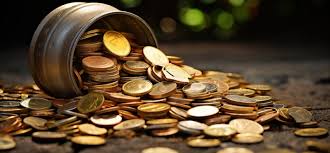Gold has been intertwined with human civilization for thousands of years, embodying wealth, power, and economic stability. As societies evolved, the role of gold as a form of money became a cornerstone of economic systems worldwide. Despite the advent of paper currency and digital transactions, gold continues to hold a unique position in the financial landscape. This article explores the history, significance, and enduring value of gold as a form of money.
The Historical Significance of Gold
Gold’s allure dates back to ancient civilizations. The Egyptians, renowned for their advanced culture and wealth, were among the first to use gold extensively. Gold was not only a symbol of the divine and the eternal but also a medium of exchange. The Pharaohs amassed vast amounts of gold, using it to build temples, create jewelry, and pay workers.
In ancient Greece and Rome, gold coins became the standard for trade. The reliability of gold’s value facilitated commerce and allowed for the expansion of trade routes. These early coins established the foundation for a monetary system that was durable and consistent. Gold’s portability, divisibility, and resistance to corrosion made it an ideal medium of exchange.
The Gold Standard
The concept of the gold standard emerged in the 19th century, revolutionizing global finance. Under this system, the value of a country’s currency was directly linked to a specific amount of gold. This standard provided a universal measure of value, stabilizing international trade and investment. Countries adhering to the gold standard agreed to convert paper money into a fixed amount of gold upon request, ensuring that the currency retained its value.
The gold standard contributed to economic stability and confidence. By limiting the ability of governments to print money indiscriminately, it curtailed inflation and fostered long-term investment. However, the system was not without its drawbacks. The rigidity of the gold standard made it difficult for countries to respond to economic crises. The Great Depression of the 1930s highlighted these limitations, leading to the eventual abandonment of the gold standard.
Gold in the Modern Economy
Even after the gold standard was phased out, gold retained its importance. Central banks around the world continue to hold significant reserves of gold. These reserves act as a hedge against economic uncertainty and inflation. During times of crisis, such as the 2008 financial meltdown, the price of gold often surges as investors seek a safe haven for their assets.
Gold also plays a crucial role in the jewelry industry and technology sector. Its unique properties, including conductivity and resistance to tarnish, make it invaluable for electronic components and medical devices. The demand for gold in these industries underscores its multifaceted value beyond mere currency.known for its high purity
Gold as an Investment
For individual investors, gold offers a variety of investment opportunities. Physical gold, such as bullion and coins, provides a tangible asset that can be stored and traded. Exchange-traded funds (ETFs) allow investors to gain exposure to gold without the need to physically hold the metal. Gold mining stocks and mutual funds offer another avenue for investment, with the potential for higher returns linked to the performance of mining companies.
Investing in gold can serve as a hedge against inflation and currency devaluation. Unlike paper money, which can be printed at will, the supply of gold is limited. This scarcity, coupled with its historical stability, makes gold an attractive option for preserving wealth over the long term. However, gold prices can be volatile in the short term, influenced by factors such as geopolitical events, interest rates, and changes in market demand.
The Cultural and Symbolic Value of Gold
Beyond its economic significance, gold holds deep cultural and symbolic value. Throughout history, gold has been associated with power, purity, and prosperity. It is often used in religious artifacts, royal regalia, and ceremonial objects. Gold’s lustrous appearance and enduring quality make it a symbol of immortality and divine favor.
In many cultures, gold is a traditional gift for significant life events such as weddings and anniversaries. It represents a lasting bond and a promise of security. The cultural affinity for gold reinforces its status as a desirable and respected form of wealth.
The Future of Gold
As we look to the future, gold’s role in the global economy is likely to remain significant. While digital currencies and new financial technologies are transforming the way we think about money, gold’s intrinsic value and historical legacy provide a stability that is unmatched.
The rise of cryptocurrencies has sparked debates about the future of money. However, the volatility and regulatory challenges facing digital currencies highlight the enduring appeal of gold. Unlike cryptocurrencies, which are purely digital and lack a tangible presence, gold is a physical asset with a proven track record of value retention.
Conclusion
Gold’s journey from ancient treasure to modern investment underscores its enduring appeal. As a form of money, gold has provided a reliable store of value, facilitated trade, and served as a hedge against economic instability. Its cultural and symbolic significance further enhances its allure.
While the financial landscape continues to evolve, gold remains a timeless currency, reflecting both the history and the future of human civilization. Whether as a tangible asset or a symbol of wealth, gold’s unique properties and historical importance ensure that it will continue to shine brightly in the global economy.
